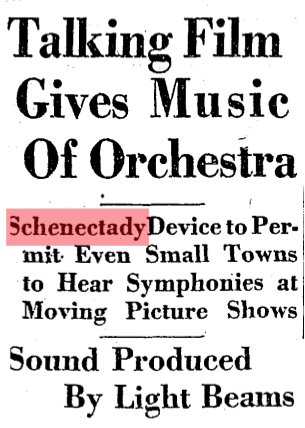
It always seems odd to think that when scientists were working on sending talking pictures by radio, having talking pictures in the theater was still a brand new thing. But in 1927, the problem of sound on film was still being worked out, and General Electric in Schenectady was on it.
An article in the New York Herald Tribune, Jan. 29, 1927:
“The photophone, a new device which records perfectly the music orchestrated for feature motion pictures, was demonstrated by the General Electric Company at a Schenectady film theater this afternoon …
“So successful was the test that persons who arrived at the theater after the performance had started did not know that the orchestra was not present. At the exact moment a pistol was fired on the screen there was the corresponding report heard from the orchestra.
“This new talking picture, the result of more than six years experimenting in the General Electric laboratories, utilizes two recent inventions of General Electric engineers – the Hoxie pallotophone and the Hewlett loud speaker … The pallophotophone makes a photographic print by means of a vibrating beam of light on the strip of film. The vibrating beam retranslates the photographic sound record into audibility when run through the reproducing machines.”
Just a couple of years ago, the Schenectady Museum decided the world once again needed a working pallophotophone; you can read about it here.
Interestingly, the developers weren’t thinking about “talking” pictures, exactly. They didn’t really contemplate dialogue as the reason to connect sound directly to the film. Silent pictures weren’t silent, of course – they were always accompanied by an orchestra or a poorly synched recorded track.
“Charles W. Stone, General Electric official, who has directed the development of the device, said after the showing that he felt the greatest possibilities were offered the small cities and towns which could now have the big film releases with the full symphony orchestras just as they were staged in metropolitan cities. ‘We all know that music has become an important part of most moving picture shows and many of us have seen a feature picture almost spoiled by a poor piano player, perhaps accompanied by a poor violinist,’ said Mr. Stone.”
